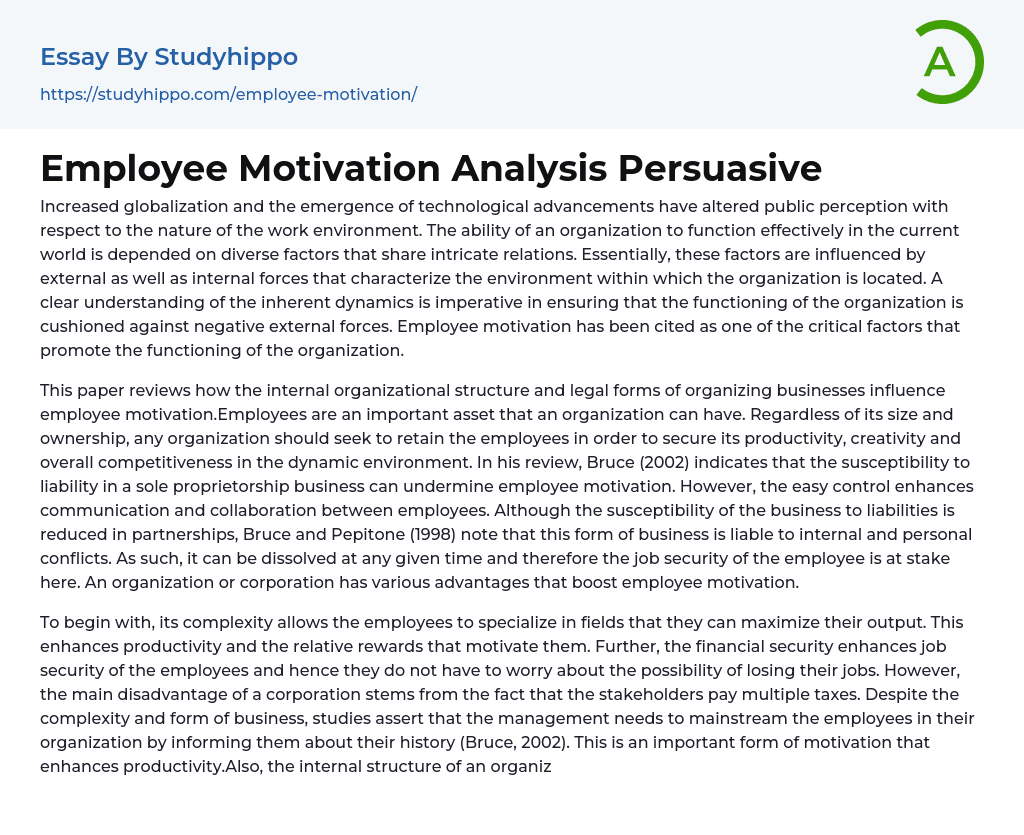Increased globalization and technological advancements have changed public perception of the work environment. The effectiveness of an organization in the modern world depends on various factors that are interconnected. These factors are influenced by both external and internal forces present in the organization's environment. Understanding these dynamics is crucial in protecting the organization from negative external influences. Employee motivation is recognized as a crucial element in promoting organizational performance.
The article analyzes how the internal structure and legal forms of businesses influence employee motivation. Employees are crucial assets for any organization, regardless of its size or ownership. It is essential for organizations to retain employees in order to sustain productivity, creativity, and competitiveness in a constantly changing environment. According to Bruce (2002), sole proprietorships are prone to liability issues that can undermine employee motivation. Nevertheless, they offer easier
...control and communication among employees. Partnerships decrease susceptibility to liability but may encounter internal and personal conflicts, posing a threat to employee job security. Organizations or corporations offer numerous advantages that boost employee motivation.
The complexity of a corporation allows employees to specialize in their areas of expertise, maximizing their productivity and motivation. It also provides financial security, ensuring job stability for employees. However, the main drawback is that stakeholders are subjected to multiple taxes. Despite the complexity, it is crucial for management to inform employees about the organization's history to enhance motivation and productivity (Bruce, 2002). The internal structure of an organization, such as line, committee, matrix, and line-and-staff, also plays a role in influencing employee motivation.
According to Weightman (2008), the line organization is more suitable for small organizations compared to complex ones. In this type of organization,
motivation is not prioritized due to the amount and complexity of work for managers and employees. Specialization is limited and can lead to confusion among employees who are expected to perform multiple tasks. On the other hand, the line and staff organization emphasizes intrinsic communication and the flow of information, which serve as motivating factors. This allows employees to utilize their specialized skills in various departments. By focusing on tasks that they excel at, employees are more likely to succeed and gain confidence. This success may encourage them to take on other related tasks and further explore their skills, as stated by Bruce (2002). Ultimately, such experiences promote excitement and rejuvenation among employees.
According to Weightman (2008), committee organization is characterized by slow decision making due to constant consultation among different individuals. The presence of diverse interests complicates the process and hampers prompt decision making, especially when conflict resolution is required. However, this type of organization is recognized for valuing the employees' needs and concerns, which fosters motivation and appreciation. Additionally, the committee's planning efforts enhance employee morale by providing clear task definitions. Ultimately, the matrix organization creates a highly motivating environment that encourages creativity and initiative. It allows employees to learn from others and focus on specific problems.
The employees have the opportunity to grow and develop due to the inherent initiative, which also enhances their critical ability and makes them feel important (Bruce & Pepitone, 1998). The implications of globalization have brought about changes in the work environment. Nowadays, organizations focus not only on enhancing productivity but also on intrinsic factors like employee motivation. This is crucial for organizational productivity and should be prioritized regardless
of the organization's form. Modifying the internal organization structure can also contribute to enhancing employee motivation.
- Career Choice essays
- Career Goals essays
- Career Plan essays
- Community Service essays
- Dream Job essays
- Duty essays
- Employee essays
- Internship essays
- Interview essays
- Job essays
- Job Interview essays
- Performance Appraisal essays
- Portfolio essays
- Service essays
- Skills essays
- Vocation essays
- Work Experience essays
- Work-Life Balance essays
- American Dream essays
- Barriers To Entry essays
- Capitalism essays
- Central Bank essays
- Compensation essays
- Consumerism essays
- Economic Development essays
- Economic Growth essays
- Economic Inequality essays
- Economic System essays
- Economy essays
- Employment essays
- Export essays
- Finance essays
- Free Trade essays
- Gross Domestic Product essays
- Human Development essays
- Income Inequality essays
- Industry essays
- Inflation essays
- International Business essays
- International Trade essays
- Macroeconomics essays
- Materialism essays
- Max Weber essays
- Microeconomics essays
- Minimum Wage essays
- Monetary Policy essays
- Monopoly essays
- Pricing essays
- Profit essays
- Recession essays




